ATTENTION: If you have a young Tree Swallow fledging unsuccessfully or prematurely, or one that you believe needs human intervention for other reason, here’s a procedure for Temporary Care of Tree Swallow Nestlings.
At Your Boxes:
It’s finally happening. Tree Swallow nestlings you’ve watched grow from eggs are fledging, leaving the boxes they’ve grown up in. They’re flying!
Contrary to what you might expect songbirds don’t “learn” to fly, and their parents don’t “teach” them. Young birds of flying species have inborn abilities to fly which develop gradually as the birds’ bodies mature. When they reach the point where they are physically ready for flight they will fly.
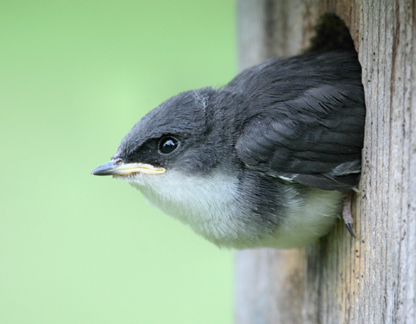
Warning! If you see a large nestling perched halfway out the entrance hole, as in the photo above, you know that fledging, the act of flying from the nest for the first time, is imminent. Please don’t approach nestlings like these or you might startle them into fledging before they are completely ready. Swallow nestlings that fledge prematurely can’t fly well and may become grounded. If this happens they are usually abandoned by their parents and die.
Please be aware that noted wildlife photographer Steve Byland, who took the above shot, takes great care not to disturb nestlings. He spent hours in a blind to get this great photo.
The youngster in Steve McLaughlin’s photo below was not so lucky. It fledged prematurely from its box along a golf course. Its puffy appearance and closing eyes signal it is in deep trouble and probably won’t survive.
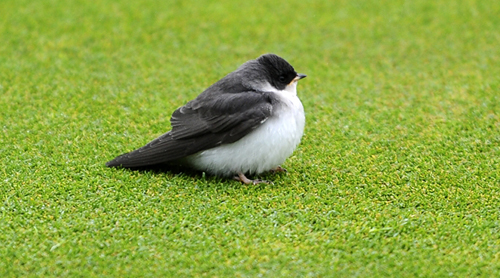
Concepts:
How old are Tree Swallow nestlings when they leave the nest? When do they begin fledging?
- The key to Tree Swallow fledging is flying ability. Tree Swallow nestlings must be able to fly well from the moment they leave the nest in order to fledge successfully.
- Young of open-nesting songbirds often leave their nests as early as day 12-14.
- Some cavity-nesting species like Tree Swallows stay in the nest longer.
- Tree Swallows fledge as early as day 18 or 19 if good weather and feeding conditions have permitted rapid nestling development.
- However, poor feeding conditions can slow swallow growth and development, delaying fledging until day 21 or 22 in some cases.
- Nestling period length can also vary with brood number. More young in a nest results in a longer nestling period, all other things being equal.
How developed are Tree Swallow nestlings at fledging?
- Nestling weight maximums, which often exceed their parents’ by day 12-14, decline as fledging nears, so at fledging nestlings weigh about the same as adults.
- Adults seem to reduce feeding rates as fledging nears, and once some of the nestlings begin to fledge parental visits to the nest decrease dramatically.
- By the normal fledging time nestling body feathers are fully grown.
- The youngsters now show the sleek new gray juvenile plumage they will wear until their first molt later in the year. See the photo below.
- However, nestling flight feathers have not completed their growth, and are only about 80% to 85% of adult length at fledging, and some nestlings will attempt to fly with wings and tail shorter than this.
- For more on the subject see Early Tree Swallow Nestling Growth and Development and Older Tree Swallow Nestling Development.
Warning! Avoid disturbing nestlings known to be near fledging since ones that are startled into fledging prematurely may not survive. (We took the picture below of 18 day nestlings many years ago before we knew better. We were very lucky they didn’t “explode” out of the box).
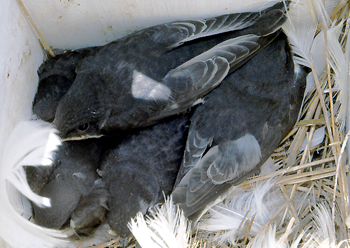
Note the gray upper body plumage of these near-fledging-age nestlings. It’s quite different from the blue-green of adult males and ASY females, and from the brown-green of SY females. For more on the sometimes confusing age-class plumage differences see Sexing and Aging Tree Swallows.
What’s it like in a nest box the last day or two before fledging?
- The best words we know to describe conditions are “hectic” and “bedlam.”
- Here’s a YouTube video of Francois Paquette’s Tree Swallow nestlings that shows what life in a box is like for 18-day-old Tree Swallow nestlings getting ready for fledging.
What happens at Tree Swallow fledging?
- Older nestlings have been exercising their wings within the boxes for days, provided there was sufficient room inside their box.
- Click here for a YouTube video of 18 day old nestlings flapping inside a box.
- At fledging young launch themselves from the entrance and try to fly.
- Click here to watch in-box video of six Tree Swallow nestlings exiting their box.
- Some fledglings fly strongly at once, and may stay airborne until far out of sight.
- Less mature young may struggle to keep aloft, and may fall to the ground or into water before reaching a solid perch.
- Adult Tree Swallows in the area will converge on and chase fledging young, pursuing them closely and calling loudly. Some people believe this behavior stimulates young to keep flying until they reach a perch. Others suggest the adults are harassing young that are not their own. We favor the first idea.
Do Tree Swallow adults care for young after they have fledged?
- Some juveniles appear to be completely independent at fledging, flying away alone without seeming to look back.
- Others continue to beg noisily, and may receive food from their parents for a few days after fledging, perhaps longer. Photo below by Tory Kallman.
- Once some nestlings fledge, the parent swallows reduce their feeding visits to the nest, which may stimulate nestlings remaining inside to fledge also.
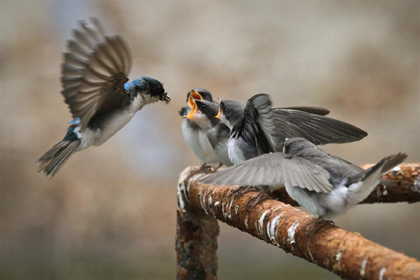
- As their flying skills improve fledglings become able to accept food passed from adults while airborne. Photo below by Gail West.
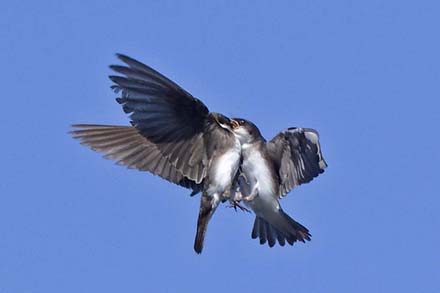
Do fledglings return to their nests?
- Fledged juveniles often flutter about, perch on, and even enter boxes. They seem especially attracted to ones still containing nestlings.
- But any returns to the nest they fledged from are probably coincidental.
- Fledglings don’t return to nests to roost, and they definitely don’t help adults feed nestlings. In fact there is evidence juveniles may enter boxes containing nestlings and out-beg them for food.
- For more on these subjects see Independent Juvenile Tree Swallows.
Have you noticed anything different in the appearance of adults lately?
- At about the time Tree Swallow nestlings begin to fledge the adults are starting their annual feather molt. Tree Swallows only molt once per year, unlike many other songbirds.
- Tree Swallow molt doesn’t happen all at once but proceeds gradually over several months, during which time all their feathers are replaced.
- Their molt, that starts on the breeding grounds in late June or early July, will continue as the swallows slowly migrate south, and won’t be finished until October or November.
- Look for notches in the wings and tails of adults where flight feathers are beginning to be lost and replaced one by one.
- For more on this subject see Tree Swallow Feather Molt and Wintering.
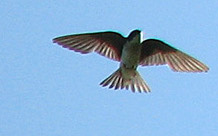
Questions for next Topic: Ectoparasites of Tree Swallows
- How can you tell if there were parasites in a box?
- What parasites do Tree Swallow nestlings sometimes have?
——————————————————————————-
Home: Tree Swallow Nest Box Projects
Creating Tree Swallow Nest Box Projects
Spring Return
Nesting Season Behavior
Song and Calls
Nest Site Claiming
Pair Formation
Nest Building
Bird Flight
Mating and Paternity
Diary of One Season at Salmon Creek
Monitoring Nest Boxes and Keeping Records
Making Box Checks Keeping Box Records Control Sheets Season Summaries Print Sheets
Banding Your Tree Swallows Banding Adults Banding Nestlings
Tree Swallows in Research Research Bibliography Glossary of Terms